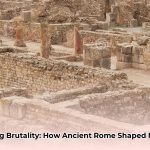Ancient Rome, an empire of unparalleled scale and influence, built its monumental achievements on a foundation deeply intertwined with slavery. The prevailing image often portrays enslaved individuals as an undifferentiated mass, relegated solely to brutal manual labor, stripped of intellectual capacity and opportunity. Yet, to truly understand the multifaceted reality of Roman servitude, one must delve beyond such simplistic assumptions. The surprising truth is that while the vast majority of enslaved people endured dire conditions, a select minority did indeed receive education, ranging from basic literacy to advanced academic pursuits. This article explores the intricate landscape of Roman slave education, revealing its pragmatic motivations, varying forms, and the profound, often contradictory, impact it had on the lives of those in bondage.
The Pragmatic Pursuit of Knowledge: Education in Roman Servitude
Slavery was not a monolithic institution in Rome; it was a vast and complex system with individuals entering bondage through diverse means—warfare, piracy, debt, or birth into servitude. Their roles were equally varied, spanning from backbreaking agricultural labor and perilous mining to highly specialized crafts and intimate domestic service. Within this immense diversity, the question of whether slaves were educated in ancient Rome reveals a nuanced reality driven primarily by utility rather than benevolence. There was no widespread, humanitarian effort to educate slaves; rather, any learning acquired was almost exclusively at the owner’s discretion, intended to enhance the slave’s capability and, by extension, their economic value to the household or business. This topic is explored further in this article about slave education. There was no widespread, humanitarian effort to educate slaves; rather, any learning acquired was almost exclusively at the owner’s discretion, intended to enhance the slave’s capability and, by extension, their economic value to the household or business.
This pragmatic approach transformed education into a strategic investment for the Roman elite. A slave proficient in accounting could meticulously manage complex financial ledgers, while a literate slave might competently handle sensitive correspondence or administrative tasks, thereby extending the master’s influence and efficiency. This instrumental perspective underscores that “slave education” was less about personal development and more about optimizing human property for maximum profit and convenience.
Who Benefited and Why? Categories of Educated Slaves
Certain categories of enslaved individuals were significantly more likely to receive instruction, demonstrating the practical application of slave education within the Roman economy and society:
- Household Administrators and Secretaries: In affluent Roman villas, domestic slaves often managed intricate household affairs, requiring skills in administration, basic accounting, and literacy. They functioned as integral elements of the household’s operational efficiency, managing supplies, supervising other staff, or acting as personal secretaries for their masters. For example, Marcus Tullius Tiro, Cicero’s freedman, became his skilled secretary, editor, and biographer, demonstrating the high level of trust and responsibility often placed in educated household slaves.
- Tutors and Educators (Paedagogi): Perhaps the most striking example, some highly educated slaves, particularly those of Greek origin (often captured during military campaigns), were prized for their intellectual prowess. They served as paedagogi, imparting knowledge of language, literature, philosophy, rhetoric, and history to the children of Roman elite families. Their expertise made them invaluable assets, ensuring the cultural and intellectual formation of future Roman leaders. The grammarian Orbilius Pupillus, Horace’s teacher, was known for his harsh methods, reflecting the rigor expected of tutors, many of whom were enslaved.
- Skilled Artisans and Craftsmen: Slaves engaged in various trades—carpenters, blacksmiths, weavers, potters, silversmiths, fullers, and even medical practitioners (medici)—learned their crafts not through formal schooling but through apprenticeships. They acquired specialized skills from master craftsmen, often fellow slaves or freedmen, ensuring the continuity of technical knowledge and enhancing the quality of goods produced. Columella, a 1st-century AD Roman writer on agriculture, provided extensive details on the management and use of skilled slave labor on Roman estates, illustrating their specialized roles.
- Public Servants (Servi Publici): Slaves owned by the Roman state sometimes held administrative positions within government offices, performing vital bureaucratic tasks. These roles frequently demanded competence in reading, writing, and arithmetic to manage records, handle official decrees, or oversee public works. For instance, imperial slaves and freedmen often ran the vast imperial bureaucracy, managing finances, correspondence, and public building projects, demonstrating the critical reliance on their specialized skills and literacy.
It is crucial to emphasize that these opportunities, while significant for the individuals concerned, were far from universal. The vast majority of enslaved individuals labored in grueling conditions in mines or agricultural estates, where literacy or advanced skills offered no perceived benefit to their owners and were therefore overwhelmingly denied. Their “training” focused on physical endurance and obedience.
| Aspect of Slave Education | Key Details |
|---|---|
| Prevalence | A small minority of enslaved individuals, predominantly those with specialized skills or domestic roles, gained some form of education. |
| Primary Motivation | To increase the slave’s utility and economic value to their owner, making them a more efficient asset or a status symbol. |
| Educational Scope | Ranged from basic literacy (reading, writing, arithmetic) and vocational training to advanced classical subjects for tutors. |
| Beneficiary Groups | Most commonly household slaves, skilled artisans, tutors, and specific public slaves contributing to Roman administration. |
| Methods of Training | Apprenticeships, direct instruction from masters or other educated slaves, self-study, and practical experience. |
| Fundamental Limitation | Despite education, slaves remained property, largely devoid of legal rights and personal autonomy, often subject to their owner’s will. |
Glimpses of Learned Lives: Documented Cases and Contradictions
While detailed biographies of individual enslaved people are rare, historical and archaeological evidence offers tantalizing glimpses. Tyrannion, a Greek scholar captured during the Mithridatic Wars, exemplifies the value placed on intellectual prowess. His extensive learning led him to prominence in Rome, where he served as a tutor to Cicero’s son, a testament to the intellectual capital of certain enslaved individuals. Similarly, the demand for medical expertise meant that some slaves were specifically trained as doctors (medici), attending to the health needs of their masters’ families and households, a role that required significant anatomical and pharmacological knowledge.
Yet, even for the fortunate few who received an education, the fundamental reality of their enslavement persisted. They remained chattel, subject to the whims of their owners, unable to fully exercise the intellectual freedom their literacy might suggest. Education offered a path to potentially better treatment, a more comfortable position, or even a higher likelihood of manumission (release from slavery), but it did not, in itself, guarantee freedom or legal rights. The complex interplay of knowledge and bondage highlights the profound contradictions at the heart of Roman society, where intellectual growth could coexist with the dehumanizing nature of absolute ownership.
Manumission: A Glimmer of Hope and Entangled Freedoms
Within the harsh realities of Roman servitude, the concept of manumission served as a profound, albeit limited, glimmer of hope. It was the formal legal process by which an enslaved person could gain their freedom, often acting as a powerful incentive for loyalty, hard work, and good behavior. This systemic release valve was crucial for maintaining order and productivity, preventing widespread despair and rebellion by offering a distant, yet attainable, goal.
Manumission could occur through several avenues:
1. Manumissio vindicta: A formal ceremony involving a magistrate, where a third party asserted the slave’s freedom, and the owner did not object.
2. Manumissio censu: The owner registered the slave as a free person during the Roman census.
3. Manumissio testamento: The owner granted freedom through their will, often upon their death.
4. Self-purchase: A slave could purchase their own freedom using a peculium, a small allowance or personal savings they were permitted to accrue. This was a powerful motivator for industriousness.
The allure of freedom spurred many enslaved people to strive for their masters’ favor, save meager earnings, or hope for emancipation through their owner’s will. It is estimated that by the 1st century AD, approximately 50% of slaves in urban areas like Rome were manumitted after a certain period of service. This prospect of achieving freedman (libertus/a) status significantly influenced the dynamics between master and slave, showcasing a subtle form of social engineering within the Roman system.
However, freedom came with its own set of complexities and continued obligations. While freedmen gained Roman citizenship, they often continued to bear significant duties to their former masters, known as patroni. These included obsequium (respect and deference), operae (specified services or labor), and sometimes a portion of their earnings. Social stigmas persisted, and their path to full integration into the elite strata of Roman society was exceptionally challenging. Despite these hurdles, manumission represented a vital step toward autonomy, offering a new life that, for many, was far superior to perpetual bondage. It demonstrated that even within a fundamentally oppressive system, routes to social mobility, however constrained, were present. The contrast between this formal path to freedom and the fierce resistance seen in events like the Servile Wars, led by figures like Spartacus, underscores the deeply conflicted nature of Roman slavery.
Imperial Interventions: Laws and Protections for the Enslaved
Roman law, while largely protecting the sanctity of property rights (including slaves), did evolve to include certain, albeit limited, protections for enslaved individuals. This raises the question: were slaves protected by Claudius’s edict or other imperial decrees? Yes, to a degree. Emperor Claudius, among other emperors, indeed took steps to curb the most extreme forms of cruelty against enslaved persons. These legal efforts, though minor in the grand scheme of the institution, reflected an evolving awareness, or perhaps a pragmatic concern for social order, regarding unchecked abuse.
Claudius famously decreed in 52 AD that masters who abandoned sick or infirm slaves would forfeit ownership of them. This meant that if a slave recovered, they would become free, rather than remaining the property of an owner who had discarded them. This measure aimed to ensure basic care and prevent the summary disposal of human beings, however utilitarian the rationale, highlighting an economic incentive to keep slaves healthy. Furthermore, Claudius reinforced that killing a slave without just cause was considered murder, holding owners accountable under the law. Vedius Pollio, an infamous example, was condemned by Emperor Augustus for his extreme cruelty, including his practice of throwing disobedient slaves into ponds of lampreys.
Later emperors expanded these protections. Emperor Hadrian (reigned 117-138 AD) forbade masters from throwing their slaves to wild beasts for public entertainment. Antoninus Pius (reigned 138-161 AD) went further, ruling that if a master killed a slave without justification, or treated them with excessive cruelty, the master could be prosecuted. The slave’s fate could then be decided by a judge. These laws, documented in Roman legal texts like the Digest, did not dismantle the institution of slavery. However, they illustrated a growing imperial concern for public order, as well as a recognition that even within the confines of absolute ownership, certain boundaries of treatment were deemed necessary. These laws, alongside the individual character of owners and the economic value of a slave, contributed to the kaleidoscopic experiences of enslaved people across the vast Roman Empire.
Early Christian Perspectives on Roman Slavery: A Moral Seed
The emergence of early Christianity within the Roman Empire presented a fascinating tension regarding the institution of slavery. How did early Christians view slavery? They navigated a society utterly reliant on enslaved labor, and their approach was characterized by spiritual equality rather than immediate social revolution. The New Testament, while not issuing an outright condemnation of slavery, provided instructions for both slaves and masters. Slaves were encouraged to obey their masters, not as an endorsement of their bondage, but as a practical instruction for living peacefully within existing social structures and avoiding unnecessary conflict that could jeopardize the nascent Christian community. Conversely, masters were admonished to treat their slaves with kindness and justice, remembering that they, too, served a higher authority (Ephesians 6:9; Colossians 4:1).
This perspective introduced a transformative idea: the inherent spiritual dignity and equality of every individual, regardless of their social standing. In the eyes of God, as articulated by the Apostle Paul, there was “neither Jew nor Gentile, neither slave nor free, nor is there male and female, for you are all one in Christ Jesus” (Galatians 3:28). This was a radical concept that subtly undermined the hierarchical foundations of Roman society, prioritizing spiritual freedom over earthly status. While early Christians, a minority group often vulnerable to persecution, did not actively campaign for widespread abolition, their teachings laid ethical groundwork that would, over centuries, contribute to changing attitudes towards human bondage throughout the Roman world and beyond. This slow, moral transformation, rather than immediate, forceful resistance, marked their unique contribution to the evolving discourse on human rights and the value of individual lives.
The exploration of slave education in ancient Rome reveals a complex tapestry woven with threads of pragmatism, cruelty, and occasional opportunity. The simplistic notion of universally uneducated, undifferentiated slaves gives way to a more nuanced understanding of varied experiences, where literacy, skill, and even intellectual pursuits, while rare, were not entirely absent. From highly valued tutors to indispensable administrators, educated slaves were an integral, if often overlooked, component of the Roman machine. Their stories, though fragmented, compel us to reconsider our assumptions, acknowledging the profound human stories within the imposing narrative of the Roman Empire, where even within the bonds of servitude, the pursuit of knowledge sometimes offered a different, albeit constrained, path.










